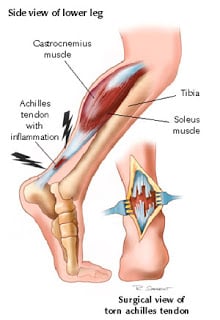
Achilles was a Greek hero, the greatest warrior, and according to Plato, the most handsome, similar to our modern day superstar athletes who garner both fame and fortune. Legend has it that Achilles was invincible, except for his heel where a small wound resulted in his death. So the term Achilles’ heel has come to mean a person’s principal weakness. More specifically, the Achilles tendon is the thickest tendon in the body, a cord that attaches the calf muscles to the heel bone (calcaneus), dictating every interaction with the ground. Over the past few years, we have seen some of the greatest athletes suffer tears in this region, a very painful rupture that generally requires surgery and months of sport absence. Yet how do these injuries begin and what can be done to avoid and heal such a crucial structure?
To further emphasize the importance of the Achilles tendon, we must address the major concept behind human locomotion; the Spring-Mass model. The mass represents the weight of the body and the spring being the behavior of the leg.
For example, during running when an athlete’ foot contacts the ground, the spring (leg) is compressed and pushes back with a force proportional to the distance of compression. This amount of force, divided by the compression distance, is stiffness. As we previously discussed, we must differentiate the subjective and English definition of stiffness (“I feel tight, sore, etc.) from biomechanics (mentioned above, which is muscle force/length). As you can see, stiffness is a good thing, allowing the leg to return momentum back to the body to avoid losing energy, to be more efficient and more explosive.
The primary determinant of leg stiffness occurs at the ankle joint. In fact, leg stiffness is relatively unchanged by the alterations of hip and knee stiffness, because these larger structures provide a higher level, leaving the least stiff spring (ankle) to have the greatest overall effect.
In April 2012, Dr Javier Maquirriain out of Argentina’s High Performance National Sports Center examined the effects of the Achilles tendon injuries on leg stiffness. Because athletic movements do not occur in isolation, the study measured ground reaction force (GRF) during jumping. Specifically the study compared athletes’ healthy legs with the other leg, which was diagnosed with Achilles tendinopathy. Tendinopathy, is a more global term for tendonitis, an overuse syndrome of the tendon characterized by pain, swelling, and decreased performance. Think of tendinopathy as a stepping stone to Achilles ruptures.
The author found that the athletes’ legs with tendinopathy had reduced stiffness, or increased compliance at the ankle joint. A similar study even found that 75% of pain-free athletes had reduced leg stiffness from underlying Achilles injuries.
Our force plate analysis shows Achilles risk in athletes with a higher first peak, as shown to the right, indicating an inability to return energy, seen as an absent mid or second peak of Force generation . The solution is FUNCTION; to teach the Achilles tendon how to absorb and return this energy or Force at ground contact. And there is nothing better for these stiffness improvements than jumping, so we use an alternation of jumps in the drill below to allow both short and long stretch shortening cycles to be trained.
Double Dowel Hops from SPARTA on Vimeo.
There are many protocols to BOTH treat and prevent Achilles injuries, but if you are not jumping in some way, you are shooting yourself in the foot.